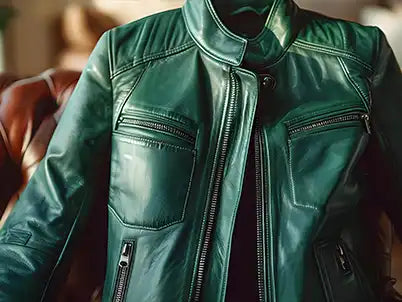Leather jackets are an everlasting trend in the fashion world. They always stand for elegance, strength, and timeless beauty. However, leather needs proper care to hold its shape, texture, and longevity. That is why understanding how to condition a leather jacket is important to keep it durable throughout the year. Learning the right steps for leather jacket care would mean ensuring that the jacket continues to please the eyes for many years to come. This guide will tell you about everything you need to know to keep your leather jacket beautiful. From finding the right leather jacket conditioner to understanding all the other essential aspects. Explore the ins and outs of protecting your investment with leather jackets.
Why Leather Conditioning is Important

Real leather jackets are big investments for fashion and comfort. But it needs care to keep the leather durable and stylish for a long time. Here is when the conditioning is required. Conditioning leather restores its soft, supple texture and acts as a barrier against wear and tear that is expected in everyday usage. When leather is not conditioned, it dries up, cracks, or loses its natural shine, thereby making your favorite jacket appear old with aging. Dirt, moisture, and sunlight are also prevented from damaging and harming the condition of the leather when conditioning is done.
Simple Steps to Condition a Leather Jacket
Proper leather jacket care keeps them in shape and texture for many years. Here are the right steps for conditioning your leather jacket:

Clean the Jacket
Before putting in any conditioner, clean the leather jacket with a damp cloth or leather-cleaning product. Ensure that the jacket is dirt-free and stain-free.
Patch Test
Before applying the conditioner all over the jacket, it is a good idea to patch-test on a small part to make sure the product does not discolor or harm the leather. Wait for 24 hours before applying to see if there has been any reaction.
Apply Leather Conditioner
After cleaning and patch testing, now your jacket is ready for conditioning. Condition the leather jacket evenly using a soft cloth. Spread the condition evenly all over the jacket and massage it into the leather with gentle circular motions. Do not miss any area of the jacket.
Remove Excess
After allowing the conditioner to sit for a couple of minutes, use a clean, dry cloth to gently wipe away any excess product. Doing this prevents greasy finishes, and ensures that the leather does not absorb more than it can handle.
Allow for Absorption
Time allows the conditioner to reside on the leather for several minutes. The leather has to absorb the moisture. Do not wipe or scrape immediately.
Repeat if Necessary
The conditioning process may be repeated if the leather is still stiff after the first application. Apply a second coat, but don’t overcondition it since this can make leather too soft or greasy.
Buff the Surface
Once the conditioner has absorbed in, buff up the leather with a clean cloth. This will help remove any excess product and restore the leather's natural sheen.
How to Choose the Best Leather Conditioner

When choosing a leather jacket conditioner, the specific type of leather of the jacket should be taken into consideration. Some conditioners work well on soft leather, such as lambskin, while others work better on thicker and more durable leather, such as cowhide. If you want a natural and cost-effective solution, then go for DIY leather conditioners. They're easy to make, good for conditioning, and bring superior hydration without breaking the bank. Find a leather conditioner that contains neatsfoot oil, lanolin, almond oil, and mink oil. They do a nice job of penetrating deep into the leather and replacing oils that are lost over time.
How Often Should You Condition a Leather Jacket?

How frequently you condition would depend on how frequently the jacket is worn and to what condition of climate it is exposed. Generally speaking, conditioning should be done on a leather jacket every 3 to 6 months. Conditioning would be on the more frequent side if living in a dry or harsh climate. The same goes for a jacket that is rarely worn and can be conditioned just once every year.
Post-Conditioning Care for Leather Jacket
Proper leather jacket care after conditioning extends the life of your jacket and keeps it looking stylish. Here are some essential tips to clean and maintain your leather jacket at home:

Store It Right
Store it away from sunlight at cool, dry places when not kept in use. Hanging on a padded hanger does pretty well in upholding its shape and preventing creases.
Avoid Moisture
Moisture is like an enemy to leather so always pass your leather jacket from any rain or too much moisture. In case of soaking, softly dab with a towel and let air dry.
Clean Immediately
If something is spilled on your leather jacket, clean it immediately. Use a dry and soft cloth to blot it, not rub it into the leather.
Dos and Don'ts for Leather Conditioning
When conditioning leather, remember to follow some basic guidelines that are essential to retaining that perfect state of your leather. Here are the key dos and don'ts for achieving the best outcome for your leather:

Do's:
- Always patch test in an inconspicuous zone of the leather before conditioning the whole jacket. This is to ensure that the conditioner does not discolor or damage the leather.
- Condition the leather using a clean soft cloth or sponge. Avoid rough materials that can scratch the leather.
- Apply small, even dabs of conditioner. Too much of it can make the leather greasy or saturated.
- After the conditioner has been absorbed, gently buff the leather surface with a soft, dry cloth.
- Based on the exposure and frequency of use, condition your leather jacket every 3–6 months to keep it soft and prevent it from drying out.
Don't:
- Conditioners with harsh or abrasive chemicals should be avoided as they may harm the leather or its natural moisture. Use products that are meant specifically for leather treatment.
- Over-conditioning or applying depressed conditioning will make the leather excessively soft and weaken its strength.
- After conditioning, let your leather jacket dry away from direct sunlight. Too much heat or sunlight can lead to cracks or fading in the leather.
- Water is very sensitive to leather. It is prohibited from cleaning the jacket with water even before conditioning because it may lead to damage or staining.
- If stains or dirt are present on your leather jacket, remove them first before applying conditioner. Conditioning over a stain locks dirt in and will only worsen the issue.
FAQs
What is best to condition a leather jacket?
Premade leather conditioner works best for conditioning leather jackets. Maintaining the leather's moisture content is essential.
What is the best oil for leather jackets?
Neatsfoot oil, lanolin, almond oil, and mink oil are best for leather jackets. These oils are natural and best for moisturizing leather.
How do you recondition a leather jacket?
Clean it thoroughly with a leather-specific cleaner, then apply a leather conditioner evenly across the surface using a soft cloth, focusing on dry areas.
What is the best homemade leather conditioner?
Conditioners that are made using beeswax and almond oil are good for leather.




















